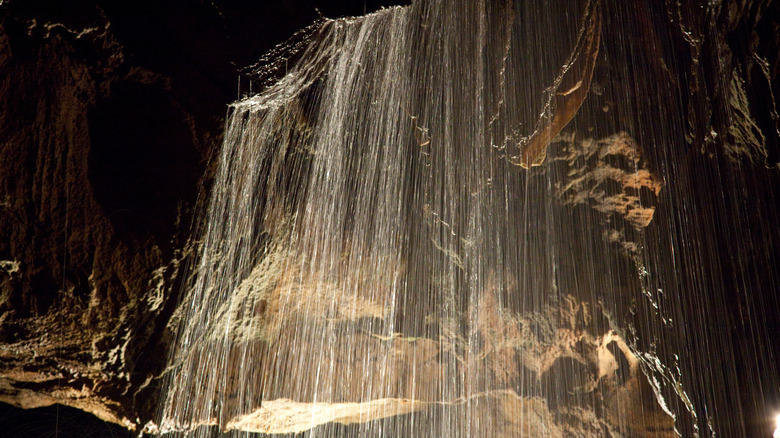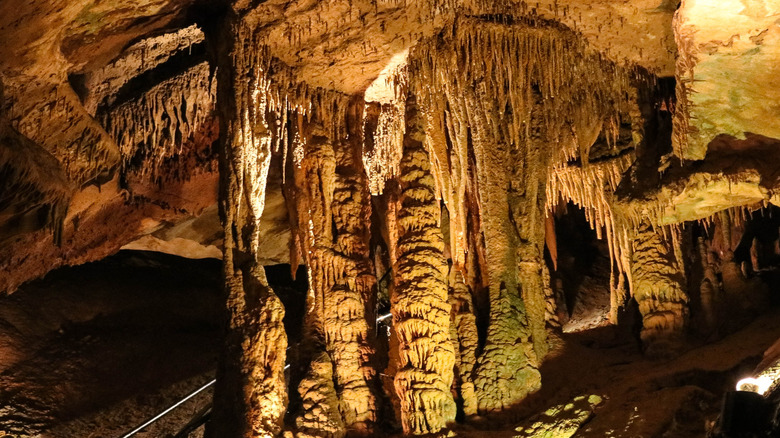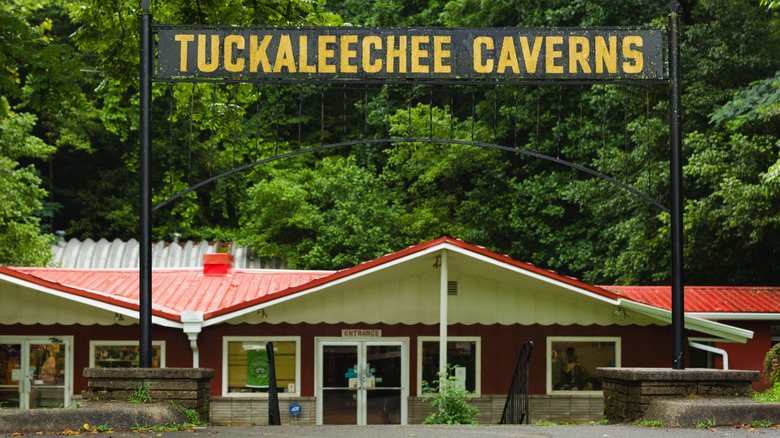
It's no secret that Tennessee is the home of the Great Smoky Mountains, Dolly Parton, and the birthplace of blues and rock n' roll. But the Volunteer State also hosts a complex underground world, one that's often overshadowed by these other big achievements. With over 11,500 caves winding underneath its majestic landscape of hidden waterfalls and lush mountains, Tennessee is by far the state with the most caves in the U.S. It may be hard to believe, but this land-locked state was once at the bottom
of a shallow sea that left limestone in its wake, a porous rock that erodes to create caves. According to the Nature Conservancy, over 20 percent of the caves in the United States are in Tennessee.
While you can take your pick of caves to visit while exploring, the Tuckaleechee Caverns are a must-visit subterranean marvel, described as the "greatest site under the Smokies." Located less than an hour from Knoxville, these 20 to 30-million-year-old caverns are home to the tallest underground waterfall in the eastern United States, towering stalagmites, and the appropriately named Big Room, which is so large it could hold an entire football field inside. It's only a 1.25-mile round-trip walk to explore these caverns, making them an ideal stop for families or anyone wanting to get a taste of Tennessee's hidden, evocative world of caves during their next mountain road trip.
Read more: The 5 Best Parks Where You Can See Bison Roam (Other Than Yellowstone), According To Visitors
Tuckaleechee Caverns' Big Room And Big History

The Tuckaleechee Caverns are a site of history spanning from the geologic to the human. The name comes from the Cherokee word Tikwalitsi (whose meaning is unknown), a reference to the Indigenous people who used the cave to protect themselves from white settlers in the 1800s. The caverns were first opened for tourists in 1931, but then closed due to the Great Depression. They reopened again in 1953, thanks to the work of locals Bill Vananda and Harry Myers. They had grown up playing in the cave and became so passionate about people seeing it that they hauled tons of sand, gravel, and cement inside to create a safe pathway for visitors.
There are some impressive sights in the Tuckaleechee Caverns that make it stand out among the thousands of caves hidden all around Tennessee. The Big Room is over 400 feet long, 300 feet wide, and 150 feet deep, which is big enough to contain a 15-story building. It also includes stalagmites growing from the floor that are up to 24 feet high, a staggering fact considering that they form at the rate of one cubic inch per century.
Tied for the pièce de résistance is Silver Falls, a massive 210-foot double waterfall that comes close to the size of Tennessee's tallest and most majestic waterfall. Only the lower section can be viewed, but you can see into the upper part, which is illuminated by lights. Just be sure to wear good shoes; the pathway can get slippery, and it includes 205 stairs. Don't forget a jacket either, since the caverns stay a cool 58 degrees Fahrenheit year-round.
Seismic Secrets In Tuckaleechee Caverns

One of the most surprising and lesser-known features of Tuckaleechee Caverns is the site's military and scientific role. As you walk into the visitor center, you might notice a screen showing live seismic activity. In the cave itself, perhaps you'll catch a glimpse of state-of-the-art sensors tucked away in rocky crevasses. It turns out that Tuckaleechee Caverns hosts the world's most sensitive seismic station, originally installed to monitor tectonic movements.
But with the beginning of the Cold War and the Cuban Missile Crisis in 1962, the U.S. government decided to enlist this station to sense nuclear activity. Since then, the Tuckaleechee Caverns seismograph has detected nuclear tests as far away as North Korea, as well as earthquakes and tsunamis on the other side of the world. It's such a precise system that "it can detect it and pinpoint any atmospheric or subterranean nuclear blast directly to the point of the initial explosion anywhere around the world, or any epicenter of any major earthquake anywhere on the planet," Benjamin Venanda, current owner of the cave and grandson of one of the men who opened it in 1953, told WVLT News.
The main reason this location is so perfect for a seismograph is its depth; so far underground, the noise pollution is minimal. It certainly helps that there aren't any major thoroughfares or intersections near the site. Plus, the sensors are connected directly to the ancient bedrock, allowing them to read movement and activity anywhere in the world.
Ready to discover more hidden gems and expert travel tips? Subscribe to our free newsletter for access to the world's best-kept travel secrets.
Read the original article on Islands.















